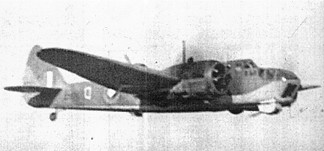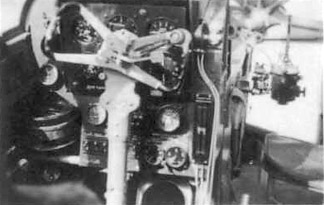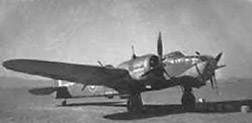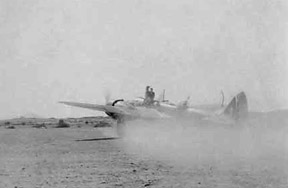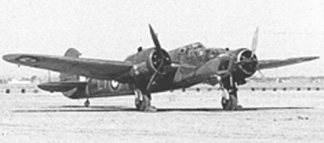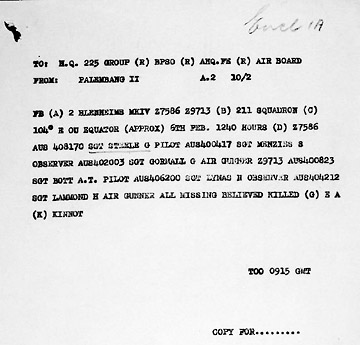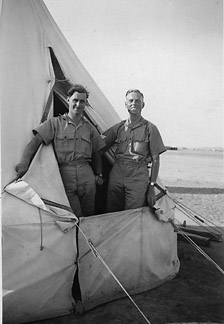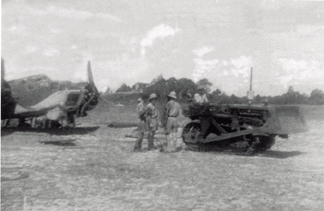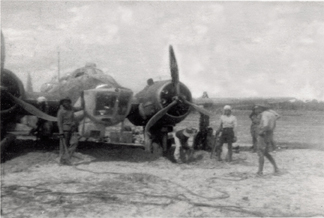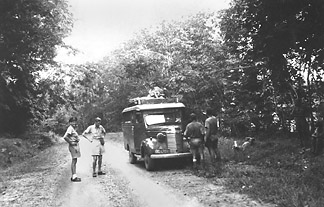|
Bristol Blenheim IV (Type 149)
Development
In 1937, with Type 142M Mark I production well in hand, Bristol put forward a tender to Air Ministry Spec G.24/35 (general reconnaissance), entitled Type 149 and eventually leading by a rather tortuous specification and tender path to the Type 152 Bristol Beaufort torpedo bomber. Meanwhile, with initial encouragement from the Air Ministry, the Bristol design team put forward a much simpler development of the Type 142M, transferring the Type 149 designation to this new project.
Bristol Type 149 Blenheim Mark IV
Q-Queenie of 211 Squadron en route FE 1942 (W Baird)
As already suggested, the pressure of the various Expansion Schemes saw mixed success in military aviation development, which the Air Ministry struggled to address. Perhaps prodded by acceptance of the Type 149 design for production in Canada as the Bolingbroke, after some hesitation the tender gained Air Ministry acceptance in the general reconnaissance role (suggesting that the Air Staff had some inkling of the deficiencies they were accepting in order to secure rapid re-equipment). For ease of production, the “new” type design saw only those modifications needed for the greater endurance required in reconnaissance: additional wing fuel tanks and (with several design attempts between mid 1937 and mid 1938) extension of the observer’s accommodation.
Into service
With production in hand from mid-1938, the first Mark IVs entered service in January 1939 having gathered some additional improvements along the way, including up-rated Mercuries and some rethinking of defensive armament.
From 1934 on, the new 87 octane petrol (to AM 1936 spec DTD.230) was available in Britain in increasing quantity. Fedden in the Bristol Engine Dept was not alone in designing for this and still higher ratings, with volume production of true 100 octane fuel expected in the immediate future.
Compared with the Blenheim I Mercury VIII of 840hp at +5lb supercharging, the Mercury XVs of the Mark IV could deliver 920hp at +9lb boost (but only with 100 octane petrol and only for an emergency limit of 30 minutes or for just 3 minutes at take-off). The engines would then be consuming 190-plus gallons per hour. The practice was to fuel up with 100 octane in the outer tanks only (maximum 188 gallons), leaving the inners for 280 gallons of 87 octane. To the peril of the crews, this invited re-fuelling (or worse, tank selection) mistakes. The Mercury XVs were liable to suffer damage and potentially serious loss of take-off power if abused with high boost on 87 octane inadvertently filled in the outer tanks.
The main visible differences from the Mark I were the extended navigator's compartment (with its complex glazing for the pilot's benefit), and the improved rear armament. Introduced in various forms, these eventually settled as a twin-gun dorsal turret and a rear-firing twin-gun chin cupola (where fitted). The airframe and fuselage interior were otherwise very little changed.
Blenheim IV cockpit, Wadi Gazouza late 1941 (Conrad collection)
Whatever the original official thinking, the Mark IV for the most part entered service with home and overseas commands in the same role as the Mark I: medium day bomber. At home for example, No 2 Group's Blenheim IVs (including 82 Squadron under the Earl of Bandon and Basil Embry’s 107 Squadron) were to suffer during the appalling period of attempted daylight operations in May-June 1940 against the German advance through Belgium and France.
Throughout this period, Battles and Blenheims of the AASF in France and the Blenheims of 2 Group Squadrons operating from England were tasked with sorties that even at the time were seen as ill-advised. On 8 May (just before the Battle of France began), Portal (CinC Bomber Cmd) signalled “I am convinced that the proposed use of these units is fundamentally unsound...we shall be lucky if we see again as many as half the aircraft we send out each time”. He was right, as was the CAS less than a week later, observing “we cannot continue indefinitely at this rate of intensity”.
The “well”
In the Blenheim IV cutaway below, the well in the wing centre-section carry-through is clearly shown. It is the oval cut-out in the space between the main and rear spars, immediately behind the pilot's seat and the navigator's fold-down seat. Used for the carriage of authorised stores, freight, a passenger in Spartan comfort and, occasionally, for the carriage of refreshments. The chin mount is the early single-Browning blister type.
Mark IV cutaway (Aviagraphica)
The normal crew was 3. Accounts of the number of additional personnel that might be carried in extremis vary. Whatever the apparent disposable weights, space was the limiting factor. Whether any more than the six or nine quoted in various sources might be carried (in addition to the crew) is debatable. Much larger numbers have sometimes been reported (although whether by an eyewitness is unclear).
Specifications
Compared to the Mark I, the principal differences were as follows:
|
Engines:
|
2x Bristol Mercury XV 9-cylinder radial. Single-stage supercharging to maximum 920hp using 100 octane fuel at +9lb boost (take-off limit 3 minutes, emergency limit 30 minutes). Using 87 octane fuel +5lb boost (take-off limit 3 minutes, emergency limit 5 minutes).
|
|
Armament:
|
Rear turret initially 1xVGO, then 2xVGO, later 2xBrowning .303in MG.
Rear-firing chin mount initially 1xBrowning, later in various forms 2xBrowning .303in MG, eg the Fraser-Nash FN54 mounting.
Mark IVF: about 60 aircraft converted, as for the Mark I, with a 4-gun belly pack.
|
|
Range:
|
1,460 miles with 1,000lb bomb load. Maximum endurance: over 7 hours.
2x94 gallon outer wing tanks in addition to the 2x140 gallon inner tanks of the Mark I. Commonly, the outer tanks were used for the 100 octane fuel.
|
|
Weights
|
Empty 9,800lb
All-up 14,500lb (Mk I: 12,200lb)
Overload (maximum take-off) variously quoted: 15,000lb or 15,800lb (Pilot’s Notes) (Mark I 12,500lb)
|
|
Speeds
|
Stalling speed, flaps and undercarriage down at 12,500lb: 60mph
Engine-assisted approach 75-80mph
Economical cruising (greatest range) 130mph
Endurance (greatest flight time) 100mph
Maximum cruising 220mph
Maximum loaded speed 266mph at 11,800ft
Maximum diving speed (Vne) 285mph
|
211 Squadron Blenheim IVs
211 briefly enjoyed the use, if not possession, of some Mark IVs in Middle East operations from Palestine. They were to take a number on charge while operating as a training squadron to form 72 OTU in the second half of 1941, and were fully re-equipped with 24 Mark IVs on transfer to the Far East in January 1942.
These lists of aircraft flown by 211 Squadron personnel were sourced principally from aircrew Flying Log Books, whether original, photocopy or transcript. In the nature of things, aircraft recorded as flown by 211 Squadron crews may not have been recorded as on 211 Squadron charge. Log Book entries or transcripts are good sources but may nevertheless contain errors, just like Operations Record Book entries. There are some disagreements with Warner’s account and with Gunby and Temple’s account.
May—June 1941, Palestine and Syria
The lack of certainty about aircraft allocations in this theatre, following heavy loss and rapid withdrawal from Greece, is apparent, as noted above for example.
Comments about aircraft sharing or loan in the 211 Squadron and 11 Squadron records for early and late May 1941 at Aquir in Palestine are notable. By 5 June the Squadron was once again on the move, back to Egypt, to prepare for aircrew training in The Sudan. From mid to end May 1941, my late father’s Flying Log Book record of aircraft numbers is partly incomplete but included clearly noted Mark IVs V5585, V5946 and “Blenheim IV 18” (presumably V5818, below).
Summary
N3581, N6178 UQ-V
V5581, V5585, V5790, V5818, V5946
Z5865, Z5887, Z5891, Z5892, Z6046
V5946
A solo photo recce to Lattaquie, Beyrouth and vicinity on 30 May for Sgts JR Marshall, CFR Clark and W Baird, “shivering like hell at 20,000”.
The UK National Archives AIR 81/7390 P4 Cas file summary records that on 17 June 1941 “Blenheim V5946, 211 Squadron” was in a ground collision, injuring Sergeant V G Hudson and Sergeant W J Johnson (with Sergeant H Morton uninjured).
The incident must be incorrectly noted in the TNA summary. Unsurprisingly it passed without remark in the 211 Squadron record: if sparse in personnel and aircraft detail, their move from Aqir on 4 June and the Air Party on 5 June is clearly recorded in the Form 540 and in my father’s Flying Log Book for that day.
So by 17 June at Aquir, V5946 was an 11 Squadron aircraft (as noted in the Air Britain published summary and in detail by Warner). The aircraft was damaged seriously enough to be struck off charge the following day.
Z5865
Z5891
WOp/AG Sgt W Wright recorded two sorties with F/O Clutterbuck: leaving Aquir on 8 May, staging to H4 Pumping Station to raid Rutbah Fort on 9 May, first in Z5865 in the morning, then in the late afternoon an abortive attempt in Z5891 only to tun back with a burst hydraulic pipe, returning safe to Aquir two days later. While Z5865 has been recorded as lost on 9 May with 84 Squadron, Z5891 was struck off charge on 14 June.
Z5887
Z5892
V5946
N3581
Flying with P/O JGM Hooper, WOp/AG Sgt JG Sharratt recorded four sorties from 15 to 31 May, in Z5887, Z5892, V5946 and perhaps N3581 (entered as N5381, an Anson I) before briefly being attached to XI Squadron. Later serving with 45 Squadron, N3581 was written off after crash-landing in a sandstorm on 30 January 1942 at Sidi bu Amud.
Z6046
Sgt W Stack’s Flying Log Book provides several more identities, having completed six operations with F/O Clutterbuck, of which two (one in “Z6064” [sic: Z6046] and one in Mark I L8410) were with 211 Squadron on 15 and 18 May. From 24 May, sorties in N6197, V5445 and another in Z6046 were noted in his Flying Log Book as 84 Squadron.
N6178 UQ-V
Also known to have been in action in Syria:
V5818
At Aquir on the morning of 28 May 1941, Sgt DV (Doug) Davis took off in Mark IV V5818 with Sgt LE Stalder and F/Sgt H Trenholm for a reconnaissance of Vichy French airfields in Syria. Shot down near Aleppo, they lie in Aleppo War Cemetery. The date of this event has been recorded variously as 27 May, 28 May and 31 May, and there are numerous variations in reported name and rank details.
The actual loss on 28 May was correctly recorded by the Squadron following a signal from RAF HQ ME, stating that a letter from the French High Commissioner Syria advised of their burial near Aleppo on 29 May. A letter from the 211 Squadron CO, W/C Macdonald, confirmed their failure to return from an operation on 28 May and concluding their loss was due to enemy action. All recorded in the Casualty file AIR 81/6685 held by UK National Archives. The crew had joined the Squadron on 7 January 1941 in Greece and had at least a dozen operations to their credit. The three were the Squadron’s last Middle East casualties in action (and their only loss of the Syria campaign).
July—December 1941, Wadi Gazouza
Mark Is and Mark IVs are both known to have been on 211 Squadron or 72 OTU charge while aircrew training at Wadi Gazouza from July to December 1941. There are very few shots of aircraft from this period, however, backroom boys Alan Conrad or his mates Con Condor and Fletch Fletcher did photograph a number of the Mark IVs.
Blenheim IV, Wadi Gazouza, 1941 (Conrad collection)
Taxiing, hatch open and LSCs bombed-up. No squadron code or individual letter but, with virtual certainty, a 211 or 72 OTU aircraft. A mixture of Mark Is and Mark IVs were available to 211 Squadron when operating as 72 OTU.
Blenheim IV, Wadi Gazouza, 1941 (Conrad collection)
Blenheim IV taxying at Wadi Gazouza (Conrad collection)
Blenheim accident Wadi Gazouza 1941 (Conrad collection)
Another anonymous 211 Squadron or 72 OTU aircraft, destroyed by fire after an accident. The crew survived.
Some details of the Mark IVs on strength have emerged, from RAAF Casualty files at the National Archives of Australia, from Log Books (particularly of some of the RAAF trainees), and in part from the invaluable Air Britain serials series cross-checked with unpublished summary data compiled by Pel Temple.
R3762
V6192, V6230, V6243, V6296, V6462
V6144
Engine cut, crashed in forced landing 55 miles ESE of Khartoum 10 November 1941. The four crew survived, injured: Sgt SJ Prentice RAAF 402135 Pilot, Sgt BW Engall RAFVR Observer, Sgt AW Thomas 402095 RAAF WOp/AG, and Sgt W Stevenson RAFVR 1104578 WOp/AG Passenger
Z6072, Z7520, Z7763, Z7781, Z7892, Z9617
Z7577
Lost in training accident. Crashed on forced-landing at Keebe Musmar, some 100 miles to the West of Wadi Gazouza on the Atbara Road, 29 December 1941.
Z7628
In the course of a night cross-country exercise on 17 December 1941, radio contact was lost about 1hr and 20min after take-off from Wadi Gazouza. Nothing further was heard and despite three days of air searching, no trace of the aircraft could be found. The crew, a staff pilot, observer and WOp/AG were flying with an observer and WOp/AG under training. All were posted missing, and have no known graves:
Pilot 748023 Sgt C Freeman
Observer P/O AC Smith RCAF
WOp/AG Sgt 755697 W Armour
Observer Sgt 1251148 PP Hussey
WOp/AG Sgt 400575 PW Wheeler RAAF.
This was the last loss of a 72 OTU aircraft and men before the 211 Squadron connection was broken on 19 December 1941, with the large-scale posting of personnel to the Squadron re-forming at Helwan.
Z6364
Returning from an engine test, Sgt HEM Ted Tyzack 404128 RAAF stalled on approach and landed on one wheel. The undercarriage collapsed. The aircraft was apparently repaired and returned to service.
Z7695
Lost in training accident. Caught fire after forced landing following mid-air collision with Mark I L1492 17 January 1942. Pilot 404121 Sgt MW Scope RAAF with his crew Observer 407590 Sgt CH Pierson RAAF and WOp/AG 406220 Sgt RP McMillan all escaped with slight burns and bruising.
Z9612
Failed to return from a low level bombing exercise Wadi Gazouza 25 November 1941. The burnt-out wreckage was found, not far away near Erkowit, on New Year’s Eve. The RAAF crew did not survive: Sgt John Skinner (pilot), Sgt Colin Dunstone (observer) and Sgt James Thomson (WOp/AG).
Z9539
On 29 November 1941, RAAF Sgts AC Longmore 407680, AGM Nourse 407180 and SC “Scotty” Thomson 400671 forced-landed in the Red Sea Hills, out of petrol after compass difficulties and unable to get a fix although in radio contact. Rescued safely the next day. The Air Britain summary records this as “Missing over Red Sea 29.11.41”, apparently a slight confusion. It is not clear whether Z9539 remained or was flown out to return to Wadi Gazouza.
Z9589
Garble for Z9539 in the 30 November signal confirming that Longmore and co were safe. This aircraft was struck off as late as July 1944.
Later 72 OTU Blenheim aircraft and aircrew training losses, after March 1942 at Nanyuki in Kenya, are beyond the scope of this account.
January 1942, Helwan
Re-formed as 211 Squadron in December 1941 for the FE posting. Partial listing of aircraft.
L9336
Mentioned by Shores, Cull & Izawa, this aircraft is recorded in two other published sources (Halley, Sturtivant) with 55 Repair and Salvage Unit in the Middle East. Crashed near Heliopolis 20 Nov 1942. Warner, however, records this loss as of Z7920 but also records that identity as an 8 Squadron aircraft shot down by flak killing the three crew on 15 July 1942 near Djibouti. No further information.
Z7622
Crewed by the Australians F/O Cuttiford, Sgts Penry and Kendrick, left Helwan on 25 January 1942 with the first Flight of six aircraft led by W/Cdr Bateson.
Z7643
Left Helwan on 28 January 1942 as Flight Commander’s aircraft of the last Flight of six aircraft. S/Ldr Kenelm (Ken) CVD Dundas DFC, Sgt GA Riddle Observer, Sgt G Chignall WOp/AG.
Z7699
P/O Bev West with Sgts Ritchie and Keeping, all RAAF, leading the second Section of three aircraft of the last Flight of six from Helwan 28 January 1942.
Z7776
All RAAF crew (Sgt JA Burrage, F/Lt David Stewart (Observer), Sgt Malcolm McDonald) departed Helwan 28 January 1942 with the last (S/Ldr Dundas) Flight of six aircraft.
Z7792
Sgt LC Hill, Sgt D Golding and Sgt G Wright formed as a crew at 13 OTU Bicester, Hill and Golding being old schoolmates. In late December 1941 they had ferried a new Blenheim IV, Z7992, out to Egypt: an aircraft that went to 14 Squadron in the Western Desert.
They were then posted as a crew to 211 Squadron in late January. Log Book errors are not that unusual: while his does show Z7992 to Egypt, then Z7792 to the Far East, it might be that they flew the same aircraft out and later with 211 Squadron.
Z7795
Mentioned by Shores, Cull & Izawa. Reported by Halley only as FE (Far East), so possible, however, may be a garble for Z7792. No further information.
Z7892
RAAF Crew Sgt JC McNamara 406459, Sgt DW Penn 407274, Sgt NA Bruce 400668 left Helwan in the third flight of six on 27 January 1942. Suffering engine failure in a sand-storm they force-landed at H4 on the oil-pipeline but an undercarriage leg collapsed on landing. Repaired, they reached Habbaniya on 4 February.
After further delay at Shaibah, they travelled in company with 45 Squadron aircraft to finally arrive at Magwe in Burma on 14 February. The next day McNamara and co flew on to Mingaladon and were attached to 45 Squadron that day. In Sumatra, with the end near, 211 Squadron were about to withdraw to Kalidjati.
At Mingaladon with 45 Squadron on 25 February, McNamara was killed and Penn wounded in a Japanese attack. Their aircraft, carrying considerable defects and damage, was ultimately withdrawn to Dum Dum. After repair, the aircraft went to 113 Squadron only to be lost over Myitkina on 16 April 1942 with S/Ldr Clifton Harper (Pilot) and P/O Leonard Beauchamp (Observer).
Z9829
Originally allotted to the RAAF men West, Ritchie and Keeping at Helwan 12 January 1942 (also see Z7699).
Z9649
Departed for the Far East flown by W/Cdr Bateson DFC, with Peter Dennis (Observer) and Bill Baird), leaving Helwan with the first flight of six aircraft on 25 January 1942.
Z9659
P/O DA Mayger, P/O EF French, Sgt Davies. Posted to 211 Squadron in January 1942, they left Helwan on 27 January in this aircraft with the third Flight.
Delayed for a week at Habbaniya, they swapped to another aircraft (V6328, possibly of 113 Squadron). They did not get to Sumatra and 211 Squadron. After further delays they arrived at Magwe in Burma on 17 February, where they were attached to 45 Squadron.
In other hands, their original aircraft Z9659 did reach the Squadron in Sumatra.
Z9660
Apparently crewed by P/O EP Coughlan with WOp/AG Sgt PLD Cummins and Sgt AP Richardson.
Z9815
Mentioned by Shores, Cull & Izawa but recorded by Halley as 107 Squadron then to the Middle East and 244 Squadron, who re-equipped with Blenheim IVs at Sharjah in April 1942 No further information.
February 1942, Sumatra and Java
At least 19 of the 24 Mark IVs taken to the Far East by 211 Squadron have now been accounted for to one degree or another. Sources include personal Flying Log Books of Baird, Cuttiford and Joerin, Keeping’s diary, RAAF casualty files, Jefford’s The Flying Camels: The History of No 45 Squadron RAF, and Warner’s Bristol Blenheim. Some uncertainties do remain, as shown.
R3733
Crewed by P/O Coughlan, Sgt Cummins and Sgt A Richardson, one of three Blenheims, possibly on 84 Squadron charge, to fly from Java 22 February 1942 to attack Japanese submarines. Previously misrecorded here as Z3733.
Mark IV Helwan Jan 1942 (EL Cooper)
This is an early Mark IV, with the single Browning Perspex nose blister. Shortly after this, 211 Squadron took rather later versions with the angular Frazer-Nash FN54 twin chin mount to the Far East, as shown by Bill Baird’s shot of Q-Queenie en route in February 1942.
Another little puzzle, this one: the aircraft is apparently coded LY, which would make it a member of 14 Squadron at that time. The undersurface blue is noticeably darker in tone than the desert-camouflaged Mark Is: see L6670 on the Blenheim I page.
From friendly correspondence with Mike Napier of 14 Squadron Association, it turned out that the aircraft is R3733, which had been on the 14 Squadron books cJune 1941 before operating with 211 Squadron at the last from Java in February 1942.
Z7521
Lost on operations in night take-off accident 11/12 February 1942 with loss of Greece veterans Clutterbuck and Newstead, gunner Joerin surviving, injured. See also Z9649.
Z7586
Lost on operations on 7 February 1942, intercepted escorting a British convoy from Singapore via Banka Straits, 407810 Sgt G Steele RAAF, 400417 Sgt S Menzies RAAF, 402003 Sgt G Gornall RAAF missing believed killed.
As recorded in the original 225 Group casualty signal of 10 February, and the later RAAF Loss Card. Sometimes reported as Z7856 (a Mark IV of 113 Squadron struck off charge as late as August 1944) or as Z7589 (a Mark IV of WDCF, which had been shot down by own AA at Gialo Oasis on 30 November 1941).
Palembang II casualty signal to 225 Group RAF & Air Board Australia, 10 Feb 1942 (NAA)
From Steele’s RAAF Casualty file A705/15 163/163/325, this is the teletype transmission copy of 10 February, tidied up somewhat for names, though still with some spelling errors. It does however make plain which crew was with which aircraft (garbled by omission in some later signals and transcripts). The original hand-written message chit in Menzies’ file was just as clear about the aircraft—although the spelling of names was worse.
The date is recorded either as 6 or as 7 February in a number of original and later documents. Here, 3 days after the action, may lie the source of that uncertainty as to date: “(Approx 6 Feb)”. Participants Cuttiford and Keeping logged it as 7 February, as Burrage did in his diary, and as Penry later reported. While Bateson entered it as 6 February in his Log Book, his gunner, Bill Baird entered 7 February. Reporting several weeks later in Melbourne, Bateson made it 7 February.
Here, too, may lie the source of confusion about when Linton and co were lost. They are not recorded on this signal: for the simple reason that it is purely an advice of RAAF casualties for the Australian Air Board. See Z9659.
Steele and his crew, and Bott and his crew, all missing in action believed killed, were never seen again. See also Z9713.
Z7622
Crewed by the Australian F/O Cuttiford with Sgts Penry and 402201 AH Kendrick, left Helwan on 25 January 1942. Took part in the first 211 Squadron reconnaissance sortie sweeping for a reported IJN aircraft carrier, while en route at Lho’nga near Koetaradja on 2 February 1942. Later recovered Riddle, Chignall and West from Pakenbaroe on 10/11 February 1942. See also Z7974.
Z7643
Had set out for the FE on 28 January with S/L KCVD Dundas DFC at the controls with his crew, Sgts Riddle and Chignall, leading the final group of six aircraft. All were old hands from the Middle East and Greek campaigns.
On 4 February 1942, S/L Dundas DFC & co in Z7643 departed Lho’nga, close by Koetaradja on the northern tip of Sumatra, for Pakenbaroe: a leg of some 550 miles and 3hr 50m flying time.
Sgt GA Riddle and friend c1941 (GA Riddle collection via Ian Carter)
This has all the look of an "our tent" shot, somewhere in the Middle East—there is a substantial hangar in the far background, and the foreground is sandy and well-marked with many a footprint.
From the collection of the late GA “Jimmy” Riddle—he is standing on the right. The longish shadows suggest either early morning or late afternoon. Both men wear tropicals. The faces of of their watches both hint faintly at a consistent time around 0600 or 1800hrs, so on balance likely to be late afternoon. The figure on the left seems familiar and may be Sgt Peter Dennis, who shared a tent with Jimmy.
Having refuelled at Pakenbaroe, during take-off for Palembang an oil leak developed in one engine, spotted in the nick of time by “Chig” in the turret. As commander of the flight about to depart, Ken Dundas there-upon took over Z7699, the aircraft of Bev West and co, to proceed to Palembang (as also recounted by W Op/AG JB Keeping).
Best, Riddle and Chignall remained at Pakenbaroe, Riddle arranging for repairs to Z7643. Attempting take-off a second time with West as pilot, they ran into an unconsolidated bomb crater, bending the propellers. Despite strenuous efforts at recovery and further repair, Z7643 was subsequently shot up and set afire, damaged beyond repair. Eventually F/O Cuttiford was sent back from P2 in Z7622 to rescue them early on 11 February. Jimmy recounted these adventures in So Long Singapore (see page 75).
Blenheim Mark IV Z7643 is an aircraft previously unrecorded in accounts of 211 Squadron’s Blenheim IV strength in the 1942 Far East operations. Aircraft records for both the Middle East and the Far East at this difficult period are known to be sparse and incomplete, as the mostly reliable Air Britain RAF Aircraft volumes carefully note. In this case, the volume for serials Z1000—Z9999 is in error regarding the fate of Z7643, recording it as lost in service with another Squadron altogether. The late Gordon Chignall’s log, however, confirms the identity of the aircraft. Other details of the adventure were confirmed thanks to Ian Carter and the log of the late Jimmy Riddle.
Not surprisingly, photographs of this period are also scarce. Those that do survive include many damaged by heat-affected processing. The shots of Z7643, below, show just this sort of damage. All in all, we are very lucky to be able to see them at all, thanks to Gordon Chignall who long kept them safe. His two photographs, previously unpublished, were major additions to the known collection of shots of 211 Squadron aircraft in the Far East in 1942. The few others are of aircraft in transit: Bill Baird’s Q-Queenie (above), Fred Joerin’s turret shot, and Mike Sainsbury’s Bahrein shot.
Z7643 Pakenbaroe February 1942 (Gordon Chignall)
In the filled but unconsolidated bomb crater.
Z7643 Pakenbaroe February 1942 (Gordon Chignall)
Little damage evident other than the props.
George Albert “Jimmy” Riddle of Mold, Flintshire died on 12 January 2004 and his friend Gordon Chignall of Midhurst, Sussex, on 11 July 2004. It is his copy of Gordon-Finlayson’s Epitaph for a Squadron that by good fortune is now in my collection.
Z7699
Allotted to West, Ritchie and Keeping for the ferry flight to Sumatra. Shot down on night operations 10/11 February 1942 over Kluang. As recorded on RAAF Loss Card and by No 1 Search Party on recovery of aircraft and remains in 1947. S/Ldr KCVD Dundas DFC RAF, P/O GR Ritchie 400543 RAAF Observer, 404294 Sgt JB Keeping WOp/AG RAAF KIA.
Z7776
Sgt JA Burrage, F/Lt David Stewart (Observer), Sgt Malcolm McDonald all RAAF. Arrived Lho’nga airfield near Koetaradja 3 February. Departed for Pakenbaroe 4 February, where Dundas’ aircraft went u/s. Arrived Palembang at dusk in a storm but landed safely. Overshot night-landing in a tropical storm at Palembang P1 on returning from Banka Strait offensive sweep on 13 February. Undercarriage collapsed, flap torn off, port airscrew bent, fuselage damaged. Crew safe.
Z7792
Having joined 211 Squadron at Helwan in late January 1942, Sgt LC Hill, Sgt D Golding and Sgt G Wright were apparently allotted Z7792 (sic). With Cpl Fitter IIA WG Hillman as passenger, they set out for the Far East in the first flight of six aircraft led by CO W/Cdr RN Bateson DFC on 25 January. The Flight encountered a sandstorm en route to Habbaniya, setting down at H4 Pumping Station overnight before continuing. From Habbaniya, the aircraft flew on to Bahrein, Sharjah, Karachi, and Allahabad.
Here Hill and co in Z7792 struck trouble: engine failure on take-off, with 87 octane in the outer tanks instead of the 100 octane required for takeoff boost. Five days passed before they set off again, solo, to reach Dum Dum on 9 February. A brief sequence of unserviceability and of recall delayed their arrival at Mingaladon until 12 February, flying on to Loh’nor (Lhok Nga) in Sumatra that day to reach Pakenbaroe on 13 February. Their Squadron was already flying operations from Palembang PII. On 17 February Hill and Co flew Z7792 from Pakenbaroe to Batavia to join the remnants of the Squadron, reaching Kalidjati the next day. They did not take part in the Squadron’s operations on Sumatra or Java. Evacuated aboard Kota Gede on 27 February, all four men survived the war.
Z7795
Mentioned by Shores, Cull & Izawa. Reported by Halley only as FE (Far East), so possible, however, may be a garble for Z7792. No further information.
Z7855
Flown by Squadron CO W/Cdr RN Bateson DFC, Peter Dennis (Observer) and Sgt W Baird (WOp/AG) in Sumatra: on 13 February 1942 sweep for the Japanese invasion fleet, returning to P1 in vile weather that made landing at P2 impossible and resulting in the loss of two aircraft; returning to P2 in that aircraft on 14 February; on 15 February attack on Japanese invasion barges in the Moesi River at Palembang. Bateson & co then flew this aircraft from P2 on 16 February on evacuation to Batavia with five groundcrew as passengers.
Z7974
Shown by Shores, Cull & Izawa as the aircraft of P/O A Devenish 45422 RAF, with P/O JO Penry RAAF (400542) and a P/O J Ensell en route to Sumatra. There was an F/O J Ensel 82978 RAF in the General Duties Branch at that date though no other apparent record of association with 211 Squadron.
It’s possible that the aircraft was flown by Devenish at some point and just possibly with these men, however, it is certain from the Log Book of F/O Cuttiford that Penry and Kendrick were his crew, flying in Mark IV Z7622 as above, from Helwan with Bateson’s 25 January Flight.
It is seems possible that the aircraft identity is also garbled, as it is recorded by Air Britain as having last been on charge with 60 Squadron and struck off charge as late as November 1944. Conceivably Z9714?
Z9649
Flown by Bateson & co leading the second, relieving flight for the 7 February convoy escort.
Subsequently lost on operations in the Palembang P2 night take-off accident 11/12 February 1942, F/O Bev West RAAF and Greece veterans Sgt Gordon Chignall RAF and Sergeant Jimmy Riddle RAF surviving, injured. See also Z7521.
Sumatra 14 February 1942 (GA Riddle collection via Ian Carter)
The place and date as marked on the rear.
The vehicle seems to be a Chevrolet bus of around 1939 vintage. Stopped for a break on a well-formed unsealed road in wooded country, the driver's door is partly open, obscuring what may be markings on the side panel near the door.
Eight men in shot, three of them sitting or standing in the shade of the trees. The airman on the roof bears a slight resemblance to Sgt W Bill Baird. On the road, two officers face the camera, one wearing an RAF hat, the other with binoculars in case, both in good humour. There are other men, at least one, aboard the vehicle. The men are in high spirits, as the clowning figure on the bus roof and the smiles suggest.
Jimmy Riddle’s injuries on the night of 11 February included concussion, cracked ribs and a broken leg. West had a lacerated face and sprained ankle. Chig, trapped under the wing of the Blenheim for some time, had sprained his back. All three were evacuated by bus the next day, with a few others. It is possible that this is on that occasion, but it is a very relaxed scene, with no arms of any sort in evidence, nor tin hats, and no hint of tension, urgency or proximity to enemy action.
Z9659
Originally the aircraft of P/O DA Mayger, P/O EF French, Sgt Davies on departure from Helwan. Their aircraft, delayed at Habbaniya, was to reach Sumatra in other hands only to be lost on returning from the 7 February convoy escort duty, according to Burrage and Penry.
One of three aircraft attacked in the course of that duty, to crash near P2 on return. F/Lt Ken Linton RAF (an old 84 Squadron hand from Greece operations) did not survive: recovered from the crash, he died the next day as Flight Mechanic LAC Bob Livesey recorded in his diary. Sgt H Offord RAF, the Observer, was rescued badly injured and later evacuated by hospital ship. Sgt RL Crowe RAF WOp/AG baled out and was also rescued slightly injured, later evacuated to Ceylon per Kota Gede.
Z9660
Crewed by P/O EP Coughlan with WOp/AG Sgt PLD Cummins and Sgt AP Richardson, took part in the sweep from Koetaradja for an reported IJN aircraft carrier on 2 February 1942.
Crewed by F/O Cuttiford and co on the last 211 Squadron operation from Kalidjati on 21 February 1942 to raid Japanese shipping in the Moesi River at Palembang: 4x250lb dropped from 4,500ft.
Z9713
Lost on operations 7 February 1942, intercepted while escorting a British convoy from Singapore via Banka Straits. All crew missing believed killed: 400823 Sgt AT Bott RAAF, 406200 Sgt N Lynas RAAF, 404212 Sgt H Lamond RAAF. As recorded in the original casualty signal to 225 Group. The RAAF Loss Card and some later records garbled the serial to Z7913—a 60 Squadron aircraft lost in China Bay in August 1943. See also Z7586, Z9659.
Z9714
One aircraft of a one or two Flight strength raid from Kalidjati, Java, against Palembang, Sumatra, on 21 February lost in poor weather over the Java Sea. The all RAAF crew Sgt Burrage, F/Lt David Stewart (Observer), Sgt Malcolm McDonald (WOp/AG) missing believed killed. Partial serial recorded in family papers.
Z9815
Mentioned by Shores, Cull & Izawa but recorded by Halley as 107 Squadron then to the Middle East and 244 Squadron, who re-equipped with Blenheim IVs at Sharjah in April 1942 No further information.
Z9829 (“9820”)
One of six 211 Squadron aircraft sweeping Banka Straits for Japanese invasion forces near Banka Is late in the aftenoon of 13 February 1942. Lost that night in a monsoon storm, possibly while attempting a forced-landing, in a swamp near P2. The aircraft and the scant mortal remains of the missing RAAF crew, F/O GG Mackay 404566 pilot, P/O NH Oddie 400541 observer, P/O JH Payne 406150 WOp/AG were found in late 1967. Accounts of this loss are sometimes confused, referring to a ditching loss at sea: see also Chalmers and crew, next below.
The partial serial 9820 was noted in correspondence around the post-war recovery. Given the difficulties of 1942 it was unsurprising that, on enquiry in 2021, the RAF Museum and RAF Air Historical Branch both confirmed the absence of any Air Ministry Form 1180 (aircraft damage/loss card) for Z9829. There is an AM Form 78 Aircraft (movements) card which showed the aircraft as first taken on charge of 18 Maintenance Unit at Dumfries (then acting as an aircraft storage and packing depot) in late 1941, then short stints with the Overseas Aircraft Despatch Unit at Kemble (from 23 October 1941) then 13 OTU Bicester (from 15 November), then a typically very sparse record of movement to the Middle East (from 1 January 1942) and on to India Cmd (that is, for the Far East) from 1 February 1942. There the formal record falls silent.
Z????
One of six 211 Squadron aircraft sweeping for Japanese invasion forces near Banka Is 13 February 1942. Night-ditching in Java Sea 13 February 1942 in monsoon storm. P/O Don Chalmers 44807 RAF and WOp/AG 402202 Sgt George Kendrick RAAF rescued, P/O Tom McInerney 407273 RAAF (Observer) missing believed killed. Serial number apparently not recorded in signals or correspondence and there is no surviving Squadron operations record for 1942. See also Z9829.
Summary, Far East Losses
The lack of Squadron records has so far precluded a full account of all Squadron aircraft and losses from January to March 1942 in the Far East. However, with Log Books, personal accounts and casualty records to help sort out the muddled patchwork of published accounts, the list above represents the most complete account to date.
In Sumatra
In just one week from 6 February to 13 February 1942, the Squadron lost ten aircraft. Nine of them were lost on operations (7 February three, 10/11 February one, 11 February two, 13 February two and one written off on landing): of the 27 aircrew involved, there were 11 survivors.
On Java
Apparently the tenth and last operational loss of the Squadron during February—March 1942 came on 21 February (no survivors).
Bristol Type 160 Bisley (Blenheim Mark V)
Re-forming in India from August 1943 as a Beaufighter strike fighter unit, the Squadron gathered aircrew and groundcrew apace. There had been a difficult period in which aircraft were hard to come by, and the Squadron found that some aircrew posted-in had languished for up to 6 months in India with little or no flying time. Quite a number were accordingly detached for short periods with 308 Maintenance Unit or with the Aircrew Transit Pool, RAF Poona, in order to maintain flying currency, while parties of groundcrew were likewise detached to look after aircraft ultimately intended for issue to the Squadron.
Receiving its Beaufighters at Phaphamau in mid October, the Squadron had also been given charge of two of the unlamented Bisleys: BA990 and one of the last batch to be built, EH507. These they used briefly for flying training and later as Squadron “hacks”, for collecting aircrew, spares and other bods as they worked up.
The Mark Vs were still on charge when the Squadron moved to Ranchi in November 1943, and forward to Silchar for operations in January 1944. BA990 was struck off charge on 7 October 1944 and EH507 one week later, though whether with 211 Squadron is unclear. No photographs are currently known.
At the Aircrew Transit Pool RAF Poona on 5 November 1943, F/Sgt Philip James Russ 656508 was flying Bristol Blenheim V AZ887 on the crosswind leg of his approach to the airfield when he crashed one mile west of Poona with the flaps jammed, one up and the other down. He was alone in the aircraft, but 37 Indians in the camp village were also killed in the accident. On investigation, a 6in hand-file was found jammed in the flap actuating mechanism.
Russ is recorded in the RAF Poona Operations Record Book, rather than that of the ATP (which was kept only for a short period in 1943). He lies in Kirkee War Cemetery. Regrettably, the loss of F/Sgt Russ was not noted in the 211 Squadron record of the time, however, the Squadron narrative originally compiled by Peter Spooner in December 1945 did record his death.
At the end of January 1944 they were also allotted a North American Harvard, FE966.
Sources
72 Operational Training Unit Operations Record Book TNA AIR 29/686
211 Squadron RAF Operations Record Book TNA AIR 27/1302, AIR 27/1303.
211 Squadron Flying Log Books, transcripts and personal accounts (Bateson, Baird, Barclay, Burrage, Checketts, Clark, Cuttiford, Furmage, Golding, Hill, How, Hooper JCR, Hooper JCM, Joerin, Livesey, Marshall, Stack, Wright)
RAAF RAF Aircraft Loss Cards via D Norman
RAAF Records of Service (Series A9300, A9301) in the National Archives of Australia
RAAF Casualty Files (Series A705) in the National Archives of Australia.
RAF P4 Casualty Files at UK National Archives, AIR 81 Series, incl
AIR 81/6685 V5818 Davis, Stalder, Trenholm
AIR 81/7390 V5946
AIR 81/11085 Z7628 Freeman, Smith & Armour with Hussey and Wheeler
RAF Museum & RAF Air Historical correspondence re Z78929 (AM Form 78, AM Form 1180)
Air Historical Branch RAF Narrative: The Middle East Campaigns
Vol I Operations in Libya and the Western Desert September 1939 to June 1941 (AHB RAF/MLRS)
Air Historical Branch RAF Narrative: The Campaigns in the Far East
Vol II Malaya, Netherlands East Indies and Burma (Air Ministry/MLRS)
Bristol Blenheim IV Aeroplane AP 1530B Vol I (Air Ministry 1939/AL36 1940)
London Gazette 1948:
London Gazette 1948: Maltby Report on Air Operations During the Campaigns in Malaya and Netherlands East Indies Dec 1941—Mar 1942 HMSO
Mercury VIII, VIIIA and IX Aero-engines AP1491B Vol I 2nd Edn (Air Ministry June 1939)
Pilot’s Notes Blenheim I Aeroplane AP 1530A (Air Ministry 1939)
Pilot’s Notes Blenheim IV Aeroplane AP 1530B (Air Ministry 1939)
Pilot’s Notes Blenheim V Aeroplane AP 1530C (Air Ministry 1942)
Bristol Blenheim Bomber (Bristol Aeroplane Co c1937)
Bowyer Bristol Blenheim (Ian Allan 1984)
Campbell & Lovell So Long Singapore (Campbell 2000)
Dunnet Blenheim Over the Balkans (Pentland 2001) Riddle narrative CH XXIII, Livesey diary facsimile Ch XIX
Gunby & Temple RAF Bomber Losses in the Middle East and Mediterranean (Midland 2006)
Hall Glory in Chaos (Sembawang Assn 1989)
Halley RAF Aircraft L1000-N9999 (Air Britain 1993)
Halley RAF Aircraft T1000-V9999 (Air Britain 1997)
Halley RAF Aircraft X1000-Z9999 (Air Britain 1984)
Jefford The Flying Camels (Jefford 1995)
Neate Scorpions Sting: The Story of No 84 Squadron RAF (Air Britain 1994)
Scope As Luck Would Have It (Scope 1992)
Shores, Cull & Izawa Bloody Shambles Vol I, Vol II (Grub Street 1992,1993)
Storr Missing With No Known Grave (Storr 2006) at AWM
Sturtivant RAF Flying Training and Support Units Since 1912 (Air Britain 2007)
Warner Bristol Blenheim (Crecy 2005)
www.211squadron.org © D Clark & others 1998—2025
Site created 15 Apr 2001, last updated 24 Dec 2025. Page created 1 Jun 2001, last updated 31 Jul 2025
Home | Site Summary | Next | Previous | Enquiries | Glossary | Sources | Site links | Do it yourself | Site updates | Site Search
|


